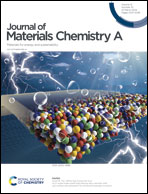A 3D binder-free rGO/NiMnCo nanosheet for highly efficient hybrid supercapacitors and ion-selective capacitive deionization†
Abstract
In this work, we investigated a one-step electrophoretic process to fabricate a rGO/NiMnCo–OH nanosheet material. The developed rGO/layered triple hydroxide (LTH) was employed in energy-efficient and cost-effective capacitive deionization (CDI)/hybrid supercapacitor systems. The structural, morphological, and crystallographic properties of the synthesized nanosheet material were studied using X-ray diffraction (XRD), field emission scanning electron microscopy (FE-SEM), Fourier-transform infrared (FT-IR) spectroscopy, energy-dispersive X-ray spectroscopy (EDS), thermogravimetric analysis (TGA), and X-ray photoelectron spectroscopy (XPS) techniques. The contact angle, zeta potential, and atomic force microscopy (AFM) analyses were conducted further to study the physical surface properties of the nanosheet electrode. In a three-electrode system in 2 M KOH solution, the rGO/NiMnCo–OH nanosheet electrode displayed a high specific capacity of 213.3 mA h g−1 with a high capacity retention of 90.1% after 3000 cycles at a current density of 1 A g−1. The assembled asymmetric rGO/NiMnCo–OH//AC device represented outstanding energy and power densities of 66.9 W h kg−1 and 800 W kg−1, respectively, with a long-term capacity retention of 93.7%, at a current density of 1 A g−1. A multi-ion water solution (including Na+, K+, Ca2+, and Mg2+ ions) with an initial concentration of 400 mg L−1 was prepared to perform CDI experiments. The rGO/NiMnCo–OH nanosheet electrode reflects an ultra electrosorption capacity of 65.1 mg g−1 at a low operating voltage of 1.2 V. The developed electrode showed a good Ca2+ selective removal behavior, and the order of removal was as follows: Ca2+ > Mg2+ > K+ > Na+.



 Please wait while we load your content...
Please wait while we load your content...